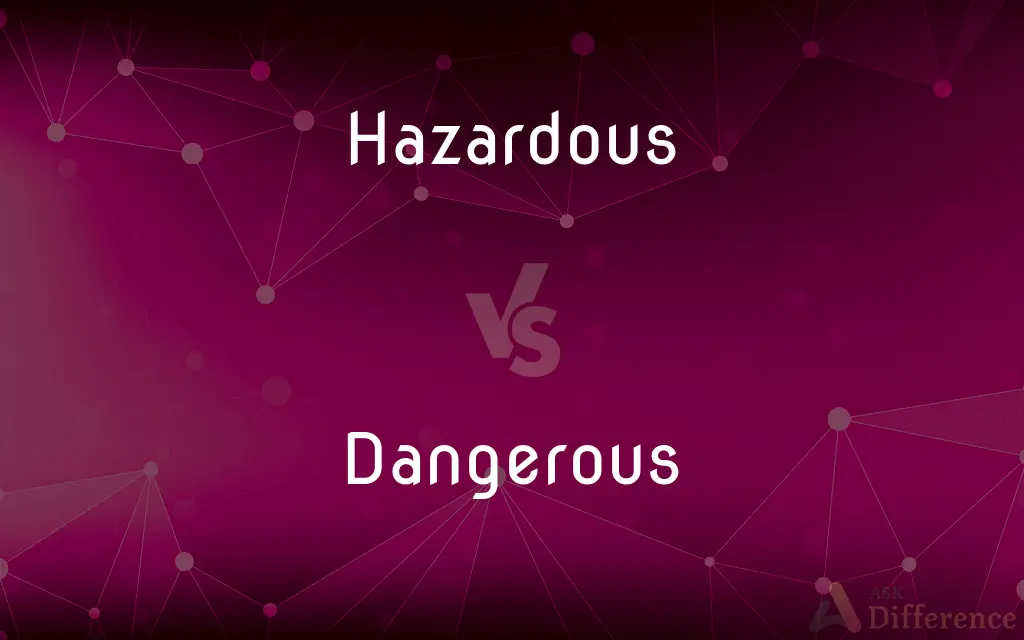Hazardous vs. Dangerous — What's the Difference?
By Tayyaba Rehman & Fiza Rafique — Updated on May 2, 2024
Hazardous specifically implies risks due to exposure to harmful agents, whereas dangerous denotes a broader potential for causing harm or injury.

Difference Between Hazardous and Dangerous
Table of Contents
ADVERTISEMENT
Key Differences
The term "hazardous" is often used in the context of materials or situations that specifically pose a risk to health, safety, or the environment due to inherent properties. For instance, chemicals or radiation are classified as hazardous. On the other hand, "dangerous" can refer to any circumstance or object that is likely to cause harm or injury, not limited to health risks, such as a dangerous animal or a precarious cliff.
Hazardous materials typically require specific handling, storage, and disposal procedures to mitigate the risks they pose. These are often regulated by safety guidelines and laws. Whereas, dealing with dangerous situations might not always involve regulated procedures but does require caution and awareness to prevent accidents or injuries.
In the workplace, the distinction can impact the type of safety measures implemented. Hazardous conditions often lead to the use of personal protective equipment and safety training specific to handling hazardous materials. Dangerous conditions, however, might focus more on general safety practices and emergency preparedness.
Labels and warnings also differ significantly; hazardous substances are marked with specific hazard symbols that indicate the type of risk, such as toxic, corrosive, or flammable. Conversely, warnings about dangerous situations are usually more general and less regulated, focusing on preventing immediate harm.
Insurance and liability considerations also vary. Exposure to hazardous materials can lead to specific health-related claims and require specialized insurance coverage, while insurance for dangerous activities or locations generally covers a broader range of potential accidents or injuries.
ADVERTISEMENT
Comparison Chart
Definition
Poses a risk due to harmful agents
Broad potential to cause harm
Context of Usage
Health, safety, environment
General safety
Regulations
Strict guidelines and laws
General safety practices
Labeling
Specific hazard symbols
General warning signs
Insurance Considerations
Health-related claims
Broader accident coverage
Compare with Definitions
Hazardous
Involving exposure to risk, particularly of a biohazardous nature.
Handling biohazardous waste requires special training.
Dangerous
Capable of threatening safety or life.
A dangerous criminal is at large in the area.
Hazardous
Potentially harmful or risky, especially to health or safety.
Hazardous chemicals should be stored in a secure location.
Dangerous
Likely to cause harm or injury.
That mountain trail is dangerous due to loose rocks.
Hazardous
Subject to legal regulation due to potential risks.
Hazardous materials transportation is tightly controlled.
Dangerous
Requiring caution to avoid potential harm.
Driving in foggy conditions is dangerous.
Hazardous
Requiring specialized handling to prevent harm.
Hazardous waste disposal must follow specific protocols.
Dangerous
Marked by a possibility of hazard or risk.
It's dangerous to handle electrical repairs without proper training.
Hazardous
Dangerous through inherent properties like toxicity or flammability.
Flammable liquids are categorized as hazardous substances.
Dangerous
Involving risk, particularly of a physical nature.
Dangerous sports require protective gear.
Hazardous
Marked by danger; perilous.
Dangerous
Able or likely to cause harm or injury
Insecticides which are dangerous to the environment
A dangerous animal
Hazardous
Depending on chance; risky.
Dangerous
Involving or filled with danger; perilous.
Hazardous
; dangerous; with the nature of a hazard.
Dangerous
Being able or likely to do harm.
Hazardous
Of or involving chance.
Dangerous
Full of danger.
Railway crossings without gates are highly dangerous.
Hazardous
Exposed to hazard; dangerous; risky.
To enterprise so hazardous and high!
Dangerous
Causing danger; ready to do harm or injury.
Hazardous
Involving risk or danger;
Skydiving is a hazardous sport
Extremely risky going out in the tide and fog
A venturesome journey in wintertime
A venturous enterprise
Dangerous
In a condition of danger, as from illness; threatened with death.
Dangerous
Attended or beset with danger; full of risk; perilous; hazardous; unsafe.
Our troops set forth to-morrow; stay with us;The ways are dangerous.
It is dangerous to assert a negative.
Dangerous
Causing danger; ready to do harm or injury.
If they incline to think you dangerousTo less than gods.
Dangerous
In a condition of danger, as from illness; threatened with death.
Dangerous
Hard to suit; difficult to please.
My wages ben full strait, and eke full small;My lord to me is hard and dangerous.
Dangerous
Reserved; not affable.
Dangerous
Involving or causing danger or risk; liable to hurt or harm;
A dangerous criminal
A dangerous bridge
Unemployment reached dangerous proportions
Dangerous
Causing fear or anxiety by threatening great harm;
A dangerous operation
A grave situation
A grave illness
Grievous bodily harm
A serious wound
A serious turn of events
A severe case of pneumonia
A life-threatening disease
Common Curiosities
What kind of training is required for handling hazardous materials?
Handling hazardous materials usually requires specialized training in safety procedures, proper use of protective equipment, and emergency response protocols.
What is the legal significance of something being classified as hazardous?
Legal implications of classifying something as hazardous include stricter regulatory compliance, potential liabilities, and mandatory safety measures to protect public health and the environment.
What makes an activity dangerous?
An activity is considered dangerous if it inherently involves a significant risk of injury or harm, such as rock climbing or skydiving.
How are hazardous substances labeled in the workplace?
Hazardous substances in the workplace are labeled with specific hazard symbols and often include information on the nature of the hazard, such as toxicity or flammability.
Can weather conditions be hazardous or dangerous?
Yes, weather conditions can be both hazardous and dangerous, such as icy roads being hazardous for driving and extreme weather like hurricanes being dangerous due to their potential for widespread damage.
What role do government agencies play in regulating hazardous materials?
Government agencies regulate hazardous materials by setting standards for safe handling, exposure limits, transportation, and disposal to protect public health and the environment.
Why might a location be considered dangerous?
A location might be considered dangerous due to environmental conditions, structural hazards, or the presence of potentially harmful wildlife, making it risky for visitors or residents.
How should one respond to a dangerous animal encounter?
In a dangerous animal encounter, it is advised to stay calm, avoid sudden movements, slowly back away, and seek help if needed to avoid provoking the animal.
Are there specific insurance policies for hazardous industries?
Yes, there are specific insurance policies designed for hazardous industries that cover risks related to the handling of hazardous materials, potential accidents, and environmental liability.
What are examples of hazardous materials in everyday life?
Common hazardous materials in everyday life include household cleaners, pesticides, car batteries, and paint thinners, all of which contain substances that can be harmful if not handled properly.
What are the consequences of not properly managing hazardous waste?
Improper management of hazardous waste can lead to environmental pollution, health risks to humans and animals, legal penalties, and significant cleanup costs.
How does one dispose of hazardous substances safely?
Disposing of hazardous substances safely requires following local regulations, using approved disposal methods, and often involves specialized facilities that can handle the environmental impact of such materials.
What precautions should be taken when dealing with a dangerous situation?
When dealing with a dangerous situation, precautions should include assessing the risk, using appropriate safety equipment, following established safety protocols, and ensuring that emergency assistance is readily available.
What are the health implications of prolonged exposure to hazardous substances?
Prolonged exposure to hazardous substances can lead to serious health conditions, including respiratory issues, skin and eye irritation, and long-term diseases such as cancer, depending on the nature of the substance.
Is it possible for a non-physical situation to be considered dangerous?
Yes, non-physical situations can be considered dangerous, such as cybersecurity threats or financial scams, which pose significant risks to security or financial stability.
Share Your Discovery

Previous Comparison
Octave vs. Sestet
Next Comparison
Decorum vs. EtiquetteAuthor Spotlight
Written by
Tayyaba RehmanTayyaba Rehman is a distinguished writer, currently serving as a primary contributor to askdifference.com. As a researcher in semantics and etymology, Tayyaba's passion for the complexity of languages and their distinctions has found a perfect home on the platform. Tayyaba delves into the intricacies of language, distinguishing between commonly confused words and phrases, thereby providing clarity for readers worldwide.
Co-written by
Fiza RafiqueFiza Rafique is a skilled content writer at AskDifference.com, where she meticulously refines and enhances written pieces. Drawing from her vast editorial expertise, Fiza ensures clarity, accuracy, and precision in every article. Passionate about language, she continually seeks to elevate the quality of content for readers worldwide.













































